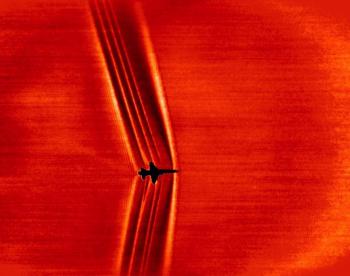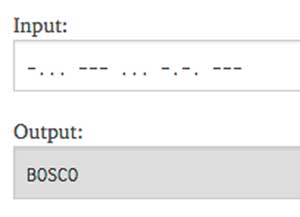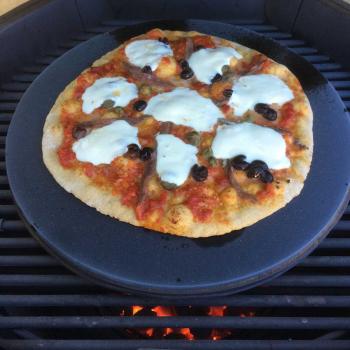-
Posts
1,738 -
Joined
-
Last visited
-
Days Won
53
Content Type
Profiles
Forums
Events
Everything posted by Syzygies
-
And your interpretation of low and slow is hotter than many of us; you report great results for example with brisket. If I always went that hot, I might not clean my grates either. I am most concerned about cleaning my grates for the second of two low and slow cooks in a row. Even if the rancidity didn't make me sick, I believe that I would taste it. And beliefs are hard to shake. This is a matter of taste. Backyard Weber chicken wouldn't be the same without that flavor of burning fat. And attempts to replicate duck confit using sous vide methods fall short because they fail to produce the characteristic rancidity of French farmhouse duck confit.
-
I blame Jon B.!!!
-
The now-classic idea of a concentrated stock is French demi-glace, where one drives all the aromatics out by fierce reduction. Several centuries ago, the true classic approach was to use one stock to make another, always at a gentle simmer. I've adopted triple stocks for gumbo, where a chicken stock leads to a crab stock leads to a lobster stock. (I then cook the reserved lobster meat sous vide in butter to serve on top, rather than destroying it in the gumbo itself.) A Chinese "supreme" stock also simmers ground chicken in an existing chicken stock. The Chinese also pioneered parboiling meats before making stock. This is vastly superior to simply skimming, and is an idea that cannot be rejected by pure thought. The spectacular, recently released Phoenix Claws and Jade Trees: Essential Techniques of Authentic Chinese Cooking devotes a chapter to stocks, with these instructions: I learned this first from Tom Colicchio. He applies this advice to protein and bones, for flavor not appearance. This proved to be such a great idea, that I then assumed it came from Thomas Keller. To my great surprise, Keller's books did not specify this step. He later came clean that of course his kitchens do this. My guess is that all great contemporary restaurants have come around to this ancient Chinese view of stock-making, they just don't believe that we want to read it from them, because we'll never take this advice. But anyone with a fraction of Thomas Keller's taste perception can discern a dramatic difference. These places stay in business by developing superior flavors in their food; these techniques are crucial. This is appropriate, even using a pressure cooker. Heston Blumenthal at Home has a chapter dedicated to pressure-cooker stocks of all kinds. He advocates double and triple stocks, and parboiling first.
-
My base line here is warm urban weekends, where parks reek of lighter fluid, dominating even the smell of burning chicken fat. So I don't trust commercial products as a rule. I have a friend who won a trip to Germany (to lose the international competition) after matching a dozen German wines blind from memory four hours later in the U.S. finals. He could pick out the coconut notes in my brisket cooked using extruded coconut lump. Most people find extruded coconut lump to be neutral. (To be fair, this was Richard's lump. Dennis is in a different league.) If I could set it up, would you be willing to bet $1,000 that my friend can't pick out which four fires out of eight were started with Weber cubes rather than a weed burner? I have a pretty good understanding of the chemistry of burning propane. This would be a safe bet, comparing a weed burner to a neutral alternative such as transferring glowing embers. I tried wax a few times; the smell took too long to go away for me. I wouldn't take this bet.
-
Here, here. After my plastic water heater pan cracked, I sprung for a metal one, with the hole stoppered with an improvised plug from found parts in same store. Even a half hour soak makes a huge difference. Then, my favorite scrubby is the thick plastic scrubby one sees in the paint department, much tougher than kitchen scrubbies. Just squeezes between the grates, naturally applying a good spring of outward pressure to clean, one just has to pull it along the grates. My drip pan / deflector is always a 16" terra cotta plant saucer, lined with two layers of heavy duty aluminum foil. Clean up after the cooker has cooled, folding both layers toward the middle without allowing a leak, and then cleanup is trivial, literally ten seconds. There's much about the ritual of using a cooker that I love, but I just can't see my love extending to washing a reusable drip pan. I ditched my rotisserie for similar reasons, it wasn't that dramatic a difference, and an absolute nightmare to clean. In Thailand, my favorite roadside barbecue never used rotisseries; they used active hands. I set my deflector on the lower grate; my cast iron Dutch oven smoke pot is generally in the way of setting it on the charcoal basket. I've given up on reclaiming drippings, as there's a tradeoff: The amount of brine and/or rub I generally use is incompatible with cooking with the drippings. Get the plain terra cotta, one never knows if a glaze meant for outdoor plants contains lead. In principle, even plain terra cotta could contain lead; I'm betting that a major Italian supplier to U.S. box stores is not using lead.
-
NASA caption: This schlieren image of a T-38C was captured using the patent-pending BOSCO technique and then processed with NASA-developed code to reveal shock wave structures. Credits: NASA image
-
I know butchers where you can. Some people actually just want flat meat, and not even the whole piece.
-
Bingo. There are actually four Chinatowns in New York City: Manhattan for tourists, Flushing for everyone in the know, and two more where many people live who work in the first two. The best bang-for-the-buck duck I've ever seen has been in the last two, including a slew of legs perfect for confit. Along with much else of interest. Games of name-that-ingredient are hardest in the last two, whatever one's upbringing.
-
It's a classic ingredient for Cassoulet, a great bean dish. Indifferent versions won't make a believer, but the best versions are astounding. This is sometimes our favorite dish of the year, but it's a lot of work. I now hover at the Basque border, making Spanish Fabada. This is often a simpler dish, but the French elaborations and technique are welcome here. (Though actually adding bread crumbs is a mythical way to accomplish the oven crust that should occur on its own, even if tourists have trained French restaurants to adopt this cheat.) (Also bear in mind that you can't get any two people in southwest France to agree on what is correct here.) The killer ingredient in any bean dish, such as either of these, is Italian pork skin sausage (Cotechino). Spotty availability, usually before Christmas; this is what chest freezers are for.
-
I wrap a 16" terra cotta plant saucer (from Home Depot) in two layers of heavy duty foil. It acts as both a heat deflector and an easily cleaned drip pan. I believe in reclaiming juices, but I gave up on this for ceramic cooking. Usually too much smoke, and too much salt.
-
Yes, those look great, and your technique is roughly the same as mine. One needs very little fat this way. If one wants some fat to borrow for pan-frying later, that's how much to use. Otherwise, less. The gelée is also worth separating, don't waste it on the fire. Various stellar cooks (Thomas Keller) have weighed in that the only authenticity one loses by this approach is the faintly rancid taste to the fat that the original technique produces. I'll pass. Same idea as burning a paella socarrat on the beach, and waxing philosophic about how good it is, because one is at the beach. I'll take golden.
-
Good! No lid in your picture, and you said enameled in your post. Just checking. The wood and chunk size is a matter of experiment, as is technique for getting the pot going in time. I usually light the charcoal under the pot with a weed burner, heating the pot at the same time. With a friend's cooker, I needed to heat up the cooker way in advance, so I heated the smoke pot in his gas grill before moving it to the cooker when I put on the meat. I actually like chips best, apple, hickory, pecan, or a mix. The meat is most receptive to the smoke early in the cook. Though some say one wants smoke throughout, the telltale smoke ring is an artificial token one manipulates early in the cook. Big chunks last longer.
-
Do you have a lid? Some of us glue the lid on each time with flour water paste; others trust a tight fit. I also worry about enamel, that the heat stress will cause it to flake. I recommend pure cast iron (funny metals such as galvanized are toxic).
-
I have a convection oven. The reviews make me wonder about rack setups that optimize for this "air frying" effect in a convection oven: Suspend one's rack well above the drip tray, and dead center in the convection breeze? Most of us haven't adapted our cooking habits to convection; this "portable convection oven" reveals what is possible.
-
As a 23" owner, I can see the 32" killer app for me would be as a bread oven. I can fit two large loaves in my 23", but I've never tried to squeeze in three loaves. I can easily find homes for three loaves. If I had a 32", I'd order a large rectangular Fibrament pizza stone, and bake away.
-
Wow. I've fed up to a hundred people out of my 23, pork butt, and yet it never feels too big, cooking for two. Brisket doesn't go as far, spareribs even less so. If I had the 32, I'd cook spareribs more often for larger groups. And whole animals would be more often an option, like baby goat, lamb, or suckling pig. At least when Laurie's out of town. Anyone thinking the 23 is too big because they're often cooking for two should just go for it, not a concern. And anyone stunned into deer-in-the-headlights inaction by this choice, again just get the 23, either it will hardly ever be too small or else you already know you want the 32. 32, wow, I have to digest this. Franklin Barbecue did weld a smoker from a 500 gallon propane tank before deciding not to waste their time like that again, they stick to 1,000 gallon tanks now. Same thing? When I think about it, it's not the money or the space, it's juggling the grates, which will weigh more. But then I custom order various 1/2" thick baking steels, they're like dumbbells and I don't mind.
-
The specs say 3/8" / 9mm. It is puzzling that a metric wrench isn't a better fit, but 10mm > 3/8", and 9mm doesn't fit.
-
A World War II code breaker would have noticed that the second and fifth set match, as do the second and fifth letters in BOSCO, in this way cracking even a much longer message.
-
-
Another Spanish rice. Love this pot! Once it settles down it is amazingly nonstick, doing all steps in the pot.
-
Well, an idea popularized by Franklin Barbecue. I share a strong prejudice against foiling (I did try it) but this is an empirical question. I make my living teaching logical thought (or mathematics, somewhat the same) and any idea that doesn't check out in practice is just BS. It sure looks like Poochie nailed it, I have to try this myself.
-
Wow, what oven do you own? I've never seen a residential indoor oven as stable as my KK. (Nice review!)
-
Huh. Laurie has fairly enlightened opinions on most matters, but she does like traditional sex roles for tasks around the house. "Man cook with fire!"
-
Burgers, and socca.
-
A pizza in mid-cook on a 15" round baking steel. I'm never going back. Custom order a thicker version if you're willing to lift and pay for one. In the KK, mine is on a stack with my old pizza stone and a heat deflector. I can go hotter without burning, using a steel. Not sure why, purely an empirical observation. Whole grain from freshly ground flour using a Wolfgang Mock grain mill; this won't look like a white flour pizza, no matter how we bake it. We roll to 1/8" thickness using a stepped J.K. Adams Lovely Maple Wood Rolling Pin. One can also buy bands or strips to get a uniform thickness. No crust, not needed with spare toppings.








